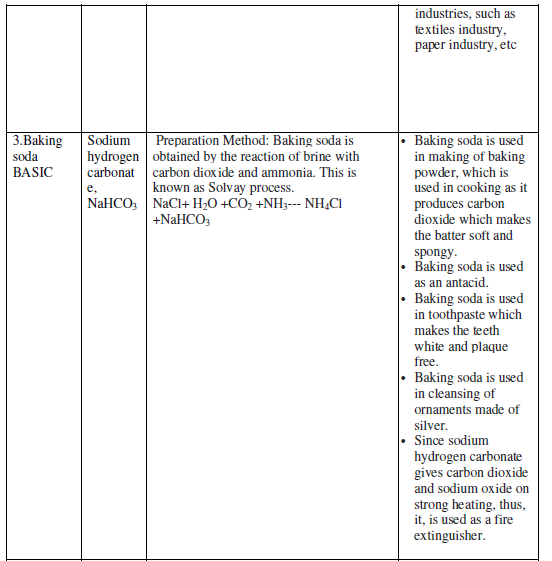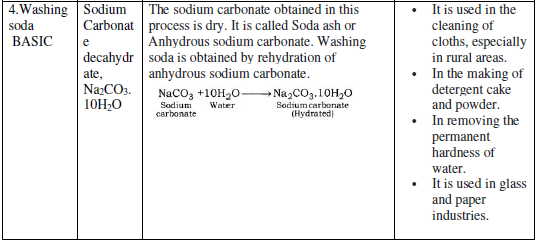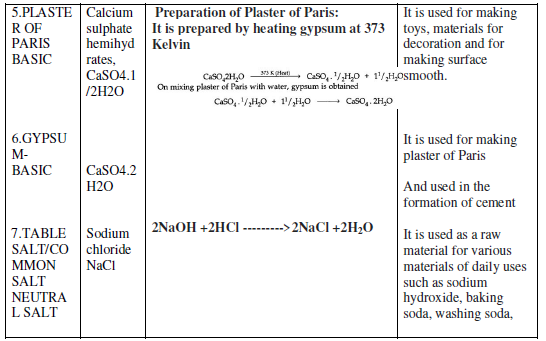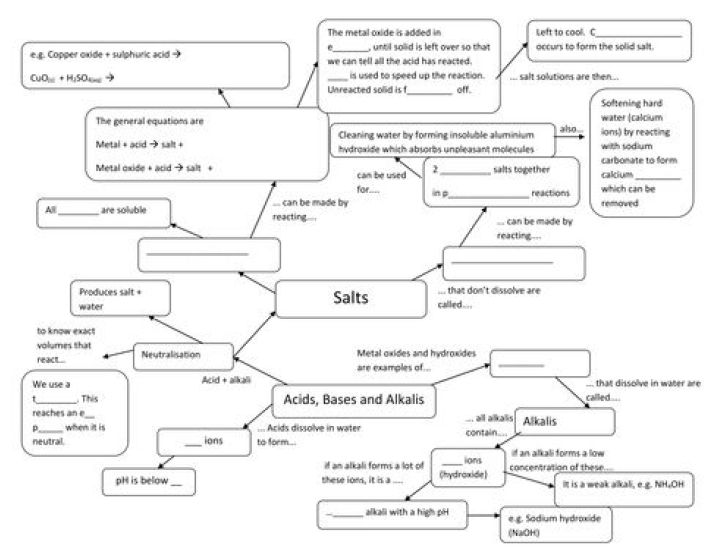Download CBSE Class 10 Chemistry Acids Bases And Salts Notes Set B in PDF format. All Revision notes for Class 10 Science have been designed as per the latest syllabus and updated chapters given in your textbook for Science in Class 10. Our teachers have designed these concept notes for the benefit of Class 10 students. You should use these chapter wise notes for revision on daily basis. These study notes can also be used for learning each chapter and its important and difficult topics or revision just before your exams to help you get better scores in upcoming examinations, You can also use Printable notes for Class 10 Science for faster revision of difficult topics and get higher rank. After reading these notes also refer to MCQ questions for Class 10 Science given on studiestoday
Revision Notes for Class 10 Science Chapter 2 Acids Bases and Salts
Class 10 Science students should refer to the following concepts and notes for Chapter 2 Acids Bases and Salts in Class 10. These exam notes for Class 10 Science will be very useful for upcoming class tests and examinations and help you to score good marks
Chapter 2 Acids Bases and Salts Notes Class 10 Science
Acids: Substances which turn blue litmus solution red are called acids. Acids are sour in taste Bases: Substances which change red litmus solution blue are called bases. They are bitter in taste.
Mineral Acids: Acids which are obtained from minerals like sulphates, nitrates, chlorides etc. are called mineral acids, e.g., H2SO4(Sulphuric acid), HNO3(Nitric acid) and HCl (Hydrochloric acid).
Organic Acids: Acids which are obtained from plants and animals are called organic acids.e.g. citric acid, ascorbic acid, tartaric acid, lactic acid, acetic acid. Hydronium Ions (H3O + ): They are formed by reaction of H+ (from acid) and H2O. It is because H+ is unstable.
Strong Acids: Acids which dissociate into ions completely are called strong acids. E.g. H2SO4, HCl
Weak Acids: Acids which do not dissociate into ions completely are called weak acids E.g. Citric acid, acetic acid.
Strong bases: The bases in which complete dissociation of hydroxide ions takes place are called Strong Bases. E.g. NaOH, KOH
Weak bases: The bases which do not dissociate completely in aqueous solution to form hydroxide ions are called weak Bases. E.g. NH4OH
Chemical properties of acids
(i) Acids react with active metals to give salt and hydrogen gas.
(ii) Acids react with metal carbonate and metals hydrogen carbonate to give salt, water and carbon dioxide.
(iii) Acids react with bases to give salt and water. This reaction is called neutralization reaction.
iv) Acids react with metals oxides to give salt and water.
Chemical properties of Bases
(i) Reaction with Metals – Certain metals such as Zinc, Aluminum and Tin react with alkali solutions on heating and hydrogen gas is evolved
(ii) Reaction with acids – Bases react with acids to form salt and water
Indicators – Indicators are substances which indicate the acidic or basic nature of the solution by their color change.
Olfactory Indicator: Substances which change their smell when mixed with acid or base are known as Olfactory Indicators. For example; Onion, vanilla etc.
Onion: Paste or juice of onion loses its smell when added with base. It does not change its smell with acid.
Vanilla: The smell of vanilla vanishes with base, but its smell does not vanish with an acid.
Olfactory Indicators are used to ensure the participation of visually impaired students in the laboratory
Universal Indicator: A universal indicator is a mixture of indicators which shows a gradual but wellmarked series of color changes over a very wide range of change in concentration of H+ ion.
pH scale: A scale for measuring hydrogen ion concentration in a solution. The pH of a solution is defined as the negative logarithm of hydrogen ion concentration in moles per litre.
PH =-log [H+] pH =-log [H3O +] where [H+] or [H3O +] represents concentrations of hydrogen ions in solution. The pH of a neutral solution is 7 the pH of an acidic solution is < 7 The pH of a basic solution is> 7
Neutral, Acidic and Basic Salts:
(i) Neutral Salt: Salts produced because of reaction between a strong acid and strong base are neutral in nature. The pH value of such salts is equal to 7, i.e. neutral.
Example: Sodium chloride, Sodium sulphate. Potassium chloride, etc.
(ii) Acidic Salts: Salts which are formed after the reaction between a strong acid and weak base are called Acidic salts. The pH value of acidic salt is lower than 7. For example, Ammonium sulphate, Ammonium chloride, etc.
(iii) Basic Salts: Salts which are formed after the reaction between a weak acid and strong base are called Basic Salts. For example; Sodium carbonate Sodium acetate, etc.




The water of Crystallization: Many salts contain water molecule and are known as Hydrated Salts. The water molecule present in salt is known as Water of crystallization.
Examples:
Copper sulphate pentahydrate (CuSO4.5H2O): Blue color of copper sulphate is due to presence of 5 molecules of water. When copper sulphate is heated, it loses water molecules and turns: into grey – white colour, which is known as anhydrous copper sulphate. After adding water, anhydrous copper sulphate becomes blue again.
EQUATIONS OF ACIDS, BASES AND SALTS
1. Acid + Metal → Salt + Hydrogen gas- H2SO4+Zn → ZnSO4+H2
2. Base+ Metal → Salt + Hydrogen gas – Na2ZnO2 + H2 → 2NaOH + Zn
3. Salt + Water → Base + Acid – NaCl (aq) + H2O (l) → NaOH (aq) +HCl (aq)
4. Acids give hydronium ions in water- HCl+H2O —>H3O+ + Cl
5. Bases generate OH- ions in water NaOH(s)+H2O → Na+ (aq)+OH– (aq)

| CBSE Class 10 Science Chemical Reactions And Chemical Equations Notes Set A |
| CBSE Class 10 Science Chemical Reactions And Chemical Equations Notes Set B |
| CBSE Class 10 Chemistry Acids Bases And Salts Notes Set A |
| CBSE Class 10 Chemistry Acids Bases And Salts Notes Set B |
| CBSE Class 10 Science Metals And Non Metals Notes Set A |
| CBSE Class 10 Science Metals And Non Metals Notes Set B |
| CBSE Class 10 Science Carbon And Its Compounds Notes Set A |
| CBSE Class 10 Science Carbon And Its Compounds Notes Set B |
| CBSE Class 10 Science Light Reflection And Refraction Notes Set A |
| CBSE Class 10 Science Light Reflection And Refraction Notes Set B |
| CBSE Class 10 Science The Human Eye And The Colourful World Notes Set A |
| CBSE Class 10 Science The Human Eye And The Colourful World Notes Set B |
| CBSE Class 10 Science Electricity Notes |
| CBSE Class 10 Science Magnetic Effect Of Current Notes |
| CBSE Class 10 Science Magnetic Effect of Electric Current Notes |
| CBSE Class 10 Science Michael Faraday Notes |
| CBSE Class 10 Science Our Environment Notes |
| CBSE Class 10 Science Biology Slides |
| CBSE Class 10 Science Full Study Material |
CBSE Class 10 Science Chapter 2 Acids Bases and Salts Notes
We hope you liked the above notes for topic Chapter 2 Acids Bases and Salts which has been designed as per the latest syllabus for Class 10 Science released by CBSE. Students of Class 10 should download and practice the above notes for Class 10 Science regularly. All revision notes have been designed for Science by referring to the most important topics which the students should learn to get better marks in examinations. Our team of expert teachers have referred to the NCERT book for Class 10 Science to design the Science Class 10 notes. After reading the notes which have been developed as per the latest books also refer to the NCERT solutions for Class 10 Science provided by our teachers. We have also provided a lot of MCQ questions for Class 10 Science in the notes so that you can learn the concepts and also solve questions relating to the topics. We have also provided a lot of Worksheets for Class 10 Science which you can use to further make yourself stronger in Science.
You can download notes for Class 10 Science Chapter 2 Acids Bases and Salts for latest academic session from StudiesToday.com
Yes, the notes issued for Class 10 Science Chapter 2 Acids Bases and Salts have been made available here for latest CBSE session
There is no charge for the notes for CBSE Class 10 Science Chapter 2 Acids Bases and Salts, you can download everything free of charge
www.studiestoday.com is the best website from which you can download latest notes for Chapter 2 Acids Bases and Salts Science Class 10
Come to StudiesToday.com to get best quality topic wise notes for Class 10 Science Chapter 2 Acids Bases and Salts

